October 1, 2022
What is the Kinesio Tape Method?
The kinesio tape method is a therapeutic taping technique used to alleviate pain and increase lymphatic flow by microscopically lifting the skin and creating more room in the space below your skin. Great, what does that mean? Kinesio tape is a specialized tape possessing a stretchy component. This makes the tape move and work with your body. Traditional athletic taping methods use rigid tape to try to hold your body in place. Kinesio tape moves with you and encourages your body to move correctly with the goal of your body learning how to move in proper patterns and eventually no longer needing the tape.
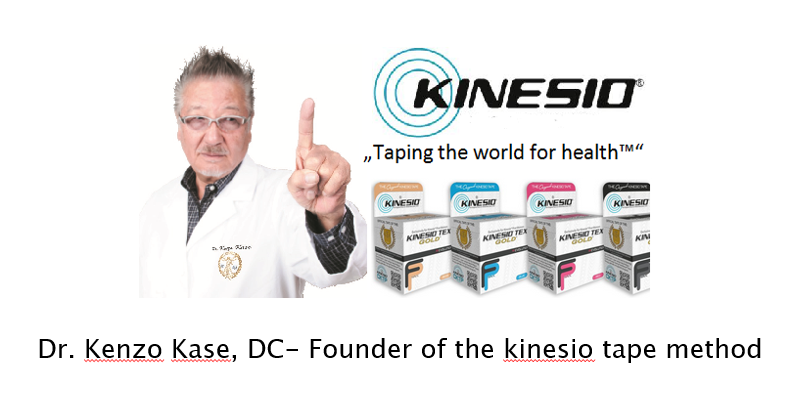
The kinesio tape method was engineered and pioneered by Dr. Kenzo Kase, DC in the early 1980s. Kinesio tape now has over 40 years of practice and research supporting the methods. Kinesio tape is placed directly on the skin, and it gently and microscopically lifts the skin away from the structures underneath. The area under the skin is medically referred to as the interstitial space. When the interstitial space is larger there is more room for the fluids of your body to flow. The increased space decreases swelling and inflammation, and it allows for increased healing when you can get the “bad stuff out” and get the “good stuff in.”
Kinesio tape also helps to relax and stimulate your muscles. The stretchy component of the tape causes the tape to move and stretch with you. This stimulates the mechanoreceptors of your skin every time you move. Mechanoreceptors are located in the skin and they detect touch, pressure, stretching, and movement sensations. These sensations help us interact, respond, and explore our environment and help us distinguish between harmful and harmless stimulation. Harmful stimulation ignites the “fight or flight” response, and harmless stimulation causes a relaxation or calming response. Kinesio tape can be applied to provide soft “harmless” stimulation to the mechanoreceptors causing them to stimulate relaxation to the surrounding tissues and muscles. We use these methods to relax tight and or painful muscles. Conversely, kinesio tape can be applied to provide gentle “harmful” stimulation to increase tightness and activity in weak muscles. These techniques are used for clients who have weakness in their muscles from injury, surgery, or neurological conditions like a stroke. Both of these techniques utilize such low-level stimulation you do not feel any discomfort, and after the first few minutes you don’t even feel the tape on your body.
Kinesio tape is most effective when it is applied by your therapist to compliment the treatment techniques utilized in the clinic. The tape can be applied to carry-over relaxation of a muscle your therapist has stretched or massage during treatment. It can also be used to stimulate a weak muscle to “fire” during strengthening exercises you are doing in the clinic or at home. I often apply the tape to decrease inflammation to an irritated area or to decrease bruising after surgery or injury. Your therapist will apply the kinesio tape to enhance the positive gains you are making in your therapy.
How do you use kinesio tape?
Kinesio tape is applied directly to the skin utilizing different amounts of stretch on the tape to create different effects. Often patients are concerned because they have experienced reactions or irritation with other types of medical tape. The glue/ adhesive in kinesio tape is extraordinarily mild and the same glue used in Band-Aids. The tape is also latex free and rarely causes skin irritation. If a client is concerned they might have a reaction to the tape a small “test piece” is applied to the forearm to assess their tolerance.
The amount of stretch applied to the tape is dependent on the intended affect/ action of the tape. As a general rule the tape is put on with less stretch than one would expect. To affect muscles the tape is placed on with 20-30% of the available stretch allowing the tape to stretch and move with your body. The direction the tape is placed determines if it is going to stimulate or inhibit/ relax your muscles. Kinesio tape can be used to decrease swelling or bruising on the skin, and we use a low 10-20% stretch on the tape for this application.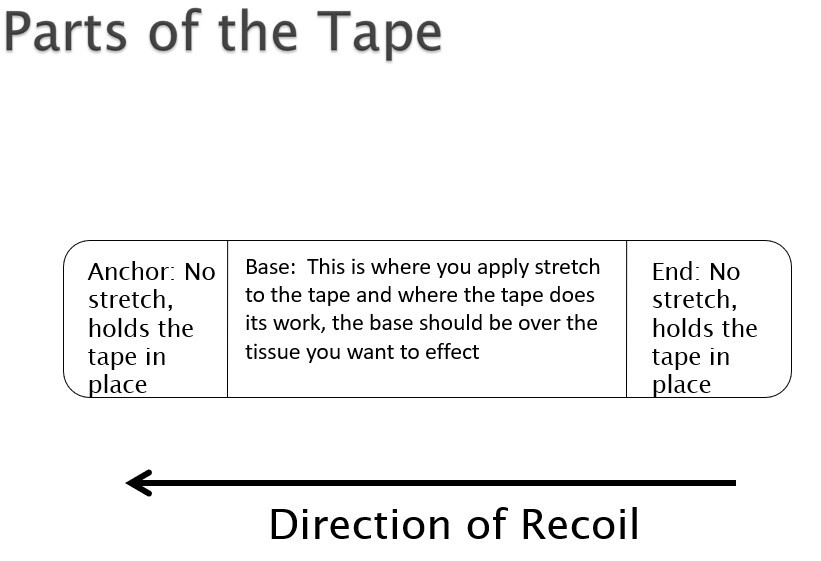 Spatial corrections are used to decrease the space your body is trying to make incorrect movements into. For example, we can use a spatial correct at the front of your shoulder to decrease your ability to slump your shoulder forward. We apply the tape with 50% stretch for these applications. We do occasionally use 75% stretch applications when we are using the tape to support strained or sprained ligaments but this is very rare. It is important to note we NEVER place the tape on your skin at 100% stretch. This takes away the “give” and flexible component of the tape thus rendering the specific properties of the tape null and void. Kinesio tape applied with 100% stretch is just expensive sports tape leading me to my last topic of conversation….
Spatial corrections are used to decrease the space your body is trying to make incorrect movements into. For example, we can use a spatial correct at the front of your shoulder to decrease your ability to slump your shoulder forward. We apply the tape with 50% stretch for these applications. We do occasionally use 75% stretch applications when we are using the tape to support strained or sprained ligaments but this is very rare. It is important to note we NEVER place the tape on your skin at 100% stretch. This takes away the “give” and flexible component of the tape thus rendering the specific properties of the tape null and void. Kinesio tape applied with 100% stretch is just expensive sports tape leading me to my last topic of conversation….
I tried that tape before, it didn’t work!
I have heard this statement from many patients. In fact, I made this statement myself before I took the Kinesio Tape Method courses and certification. Here are reasons why kinesio tape may not have worked for you in the past:
- It was put on with 100% stretch. We discussed above why this doesn’t work. I have seen MANY YouTube videos where someone is teaching you to put the tape on with way too much stretch. The tape also does not stick to the skin as well when it has a lot of stretch on it, and the more stretch the less the wear time of the tape.
- The skin was not prepped properly. When put on correctly kinesio tape should last 2-3 days or more depending on how oily your individual skin is. Ideally the skin should be washed with soap and water and dried thoroughly or cleaned with an alcohol wipe before application. This will remove any natural skin oils and lotions or other substances that may be on the skin.
- The tape was not heat activated. The adhesive used in the Kinesio Tex Brand tape (more on this below) is heat activated. The tape is made for athletes so the hotter you get the stickier the tape gets. Once the tape is put on your therapist should run the back of the tape to make the glue sticker.
- You used crappy tape. Apologies but not all tape is created equal. There are tons of different brands of kinesio type-tapes for sale in drug stores or sports stores. A lot of these tapes are not manufactured with the goals of multiple application uses, and they are made to try to “dumb down” application. Kinesio Tex brand is the best and only brand (in my opinion) for all the different applications. A physical therapist trained and certified in kinesio tape application can easily teach you how to apply your own tape using the same advanced methods we use (as long as it is an area you can reach!)
Who can Kinesio Tape Me?
The short answer is anyone! Anyone can be taught how to properly apply kinesio tape for the specific goals they want to achieve. Often kinesio tape only needs to be applied a few times during treatment sessions by your therapist. Your body learns how to move properly and the tape is no longer needed. Other times, the tape can be used to control chronic injuries or used in place of a more aggressive brace. In these cases your therapist can teach you (or a family member) to apply the tape and it can be a modality you can use independently at home to treat your condition. So what are you waiting for? Schedule your appointment at Portland Physical Therapy and if kinesio taping will be appropriate for you we will be happy to utilize this effective treatment technique.
Examples of taping
Here are some pictures of commonly used taping methods and some of my fancier and more specific taping techniques I have used.
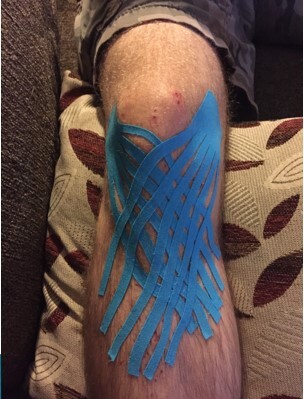
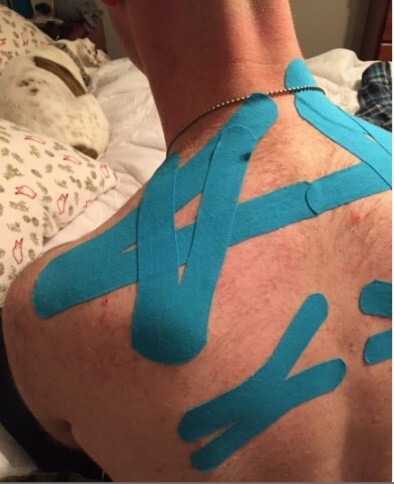
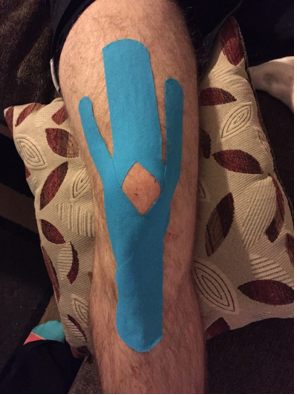
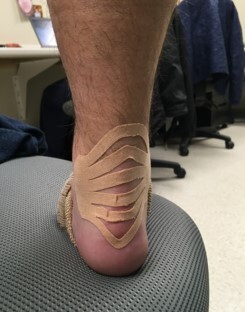
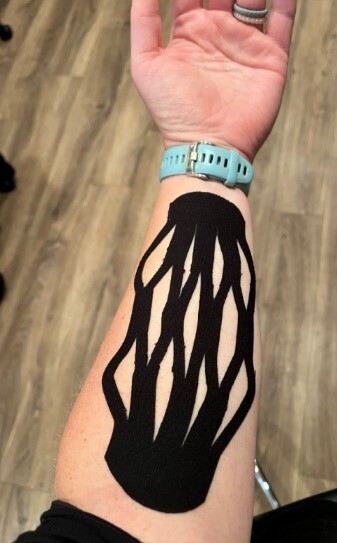
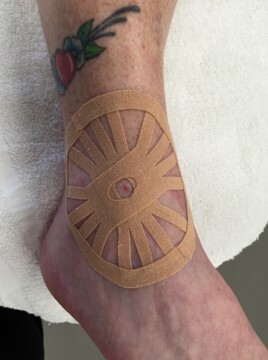
Resources
Iheanacho F, Vellipuram AR. Physiology, Mechanoreceptors. [Updated 2021 Sep 12]. In: StatPearls [Internet]. Treasure Island (FL): StatPearls Publishing; 2022 Jan-. Available from: https://www.ncbi.nlm.nih.gov/books/NBK541068/
KT 1: Fundamental Concepts of the Kinesio Taping Method. 2013 Kinesio Taping Association International
KT1: Advanced Concepts and Corrective Techniques of The Kinesio Taping Method. 2013 Kinesio Taping Association International
KT3: Clinical Concepts and Advanced Taping Methods. 2013 Kinesio Taping Association International
Kase, Wallis, Kase. Clinical Therapeutic Applications of the Kinesio Taping Method, 3rd Edition. 2013 Kinesio, IP, LLC; Albuquerque, NM.
Photo credits above and personal collection of author
Author: Laura Sugrue, PT, MSPT, OCS